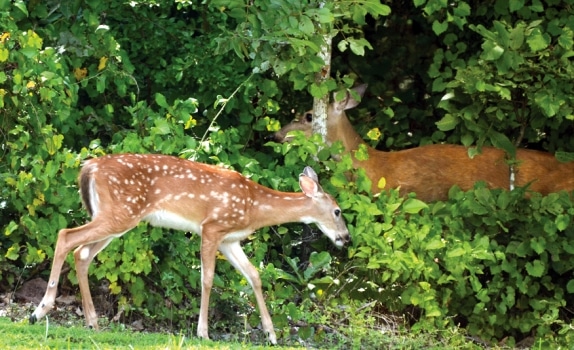Everyone knows the leaves of most deciduous trees are green during summer. Most also know that leaves grow on a tree’s branches originating in spring and falling off in the fall. However, how valuable are green leaves to deer? Extremely valuable.
Green leaves provide important food and cover for whitetails. Research at the University of New Hampshire (where I got my graduate degree) showed green leaves constituted 55 percent of the daily diet for does during summer. I’m sure this statistic would differ dramatically in, say, Iowa, but the point is green leaves are a very important food component in forested regions.
It should go without saying that for deer to eat green leaves they have to be growing within 5 to 6 feet of the ground. No offense to the leaves in the canopy, but they’re useless to whitetails from a forage perspective. Proper forest management practices ensure an acceptable percentage of the forest is in a young age class (0 to 10 years). I like to see at least 20 to 25 percent of forested acreage in this age class. Mature, closed canopy forests only provide an average of 50 to 100 pounds of browse (leaves and buds) per acre while young forests can provide up to 1,000 pounds of browse per acre. That’s the equivalent of a full grocery store vs. one where the shelves are 90 to 95 percent empty!
Interestingly, leaves growing on stump sprouts (sprouts that originate from the stump of a tree that has been cut) have a higher nutritional content than leaves from the canopy of a mature tree. This is a win-win situation as those leaves provide more nutrition, and they are within a deer’s reach (see the photo in the Gallery below). This is an example of where timber stand improvement (TSI) work such as thinning, hinge-cutting, and other techniques can drastically improve habitat quality for deer.
All leaves in a deer’s foraging zone are not equal however. Some species such as red maple, yellow birch, and red and white oak are far more preferred than American beech, white birch, ironwood and musclewood. A little observation on your part can clearly identify the more preferred species in your area.
Creating food close to the ground also provides quality cover for whitetails. Good cover can reduce fawn-predation rates and entice adults to spend more time on the property, as well as move more during daylight hours. This is good anytime and especially during the hunting season.
So, the next time you look at leaves in the woods try to view them from a deer’s perspective. Do the woods provide an abundance of preferred green leaves within 5 to 6 feet of the ground? If not, get your chainsaw and get to work.

